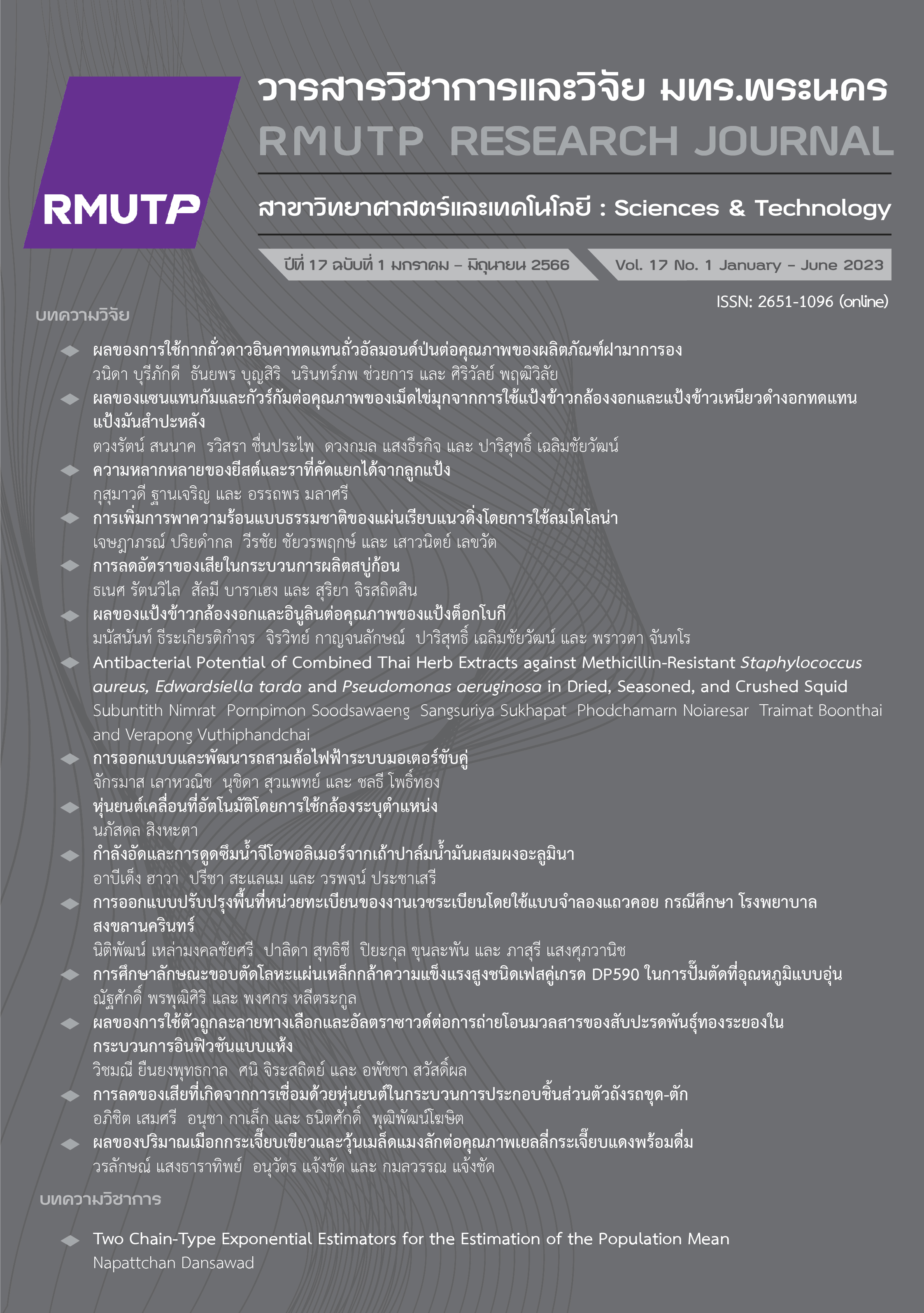Effect of Alternative Solutes and Ultrasound on Mass Transfer of Thong Rayong Pineapple in Dry Infusion Process
Main Article Content
Abstract
Dry infusion was carried out by adding sugar directly to the fruit pieces and allowing them to contact together. It was effective for removing of water from the fruit. The purpose of this research was to study the effect of using different types of alternative solutes, namely oligofructose, maltodextrin and sorbitol instead of sucrose. Mass transfer of Thong Rayong pineapple during dry infusion process showed that the solute types affect the mass transfer parameters. The use of sorbitol had the highest mass transfer value (p<0.05). Effect of ultrasound assisted mass transfer was studied. The result showed that ultrasound applied at 50±2 °C for 15 min was the optimum condition which enhanced Water Loss (WL), Solid Gain (SG) and Weight Reduction (WR) values of 37.08%, 6.58%, and 30.49%, respectively. Sensory scores in terms of appearance, color, texture, and overall preference of semi-dried pineapple from infusion process were more than semi-dried pineapple without dry infusion (p<0.05), with a moderate overall liking score.
Article Details

This work is licensed under a Creative Commons Attribution-NonCommercial-NoDerivatives 4.0 International License.
ลิขสิทธ์ ของมหาวิทยาลัยเทคโนโลยีราชมงคลพระนครReferences
D. Torregiani, “Osmotic dehydration in fruit and vegetable processing,” Food Research International, vol. 26, pp. 59-69, 1993.
S.M. Alzamora, S. Guerrero, A.B. Nieto and S. Vidales, Combined preservation technologies for fruits and vegetables: training manual, Rome: The Agricultural and Food Engineering Technologies Service, 2003.
V. A. Rao, “The prebiotic properties of oligofructose at low intake levels,” Nutrition Research, vol. 21, pp. 843-848, 2001.
A. M. Goula, M. Kokolaki and E. Daftsiou, “Use of ultrasound for osmotic dehydration. The case of potatoes,” Food and Bioproducts Processing, vol. 105, pp. 157-170, 2017.
D. Torreggiani, E. Forni, E., M.L. Erba and F. Longoni. “Functional properties of pepper osmodehydrated in hydrolyzed whey permeate with or without sorbitol,” Food Research International, vol. 28, pp. 161-166, 1995.
N. Nowacka and M. Wedzik, “Effect of ultrasound treatment on microstructure, colour and carotenoid content in fresh and dried carrot tissue,” Applied Acoustics, vol. 103, pp. 163–171, 2016.
A. Shukla, R. S. Shukla, C. Das and V.V. Goud, “Gingerols infusion and multi-step process optimization for enhancement of color, sensory and functional profiles of candied mango,” Food Chemistry, vol. 300, pp. 125-195, 2019.
V. Prosapio and I. Norton, “Influence of osmotic dehydration pre-treatment on oven drying and freeze drying performance,” LWT, vol. 80, pp. 401-408, 2017.
AOAC, Official Method of Analysis, 15th ed. Arlington: The Association of official Analysis Chemists, 1990.
A. Matusek, B. Czukor and P. Merész, “Comparison of sucrose and fructo-oligosaccharides as osmotic agents in apple,” Innovative Food Science and Emerging Technologies, vol. 9, pp. 365-373, 2008.
M.R. Khan, “Osmotic dehydration technique for fruit preservation-A review,” Pakistan Journal of Food Sciences, vol. 22, pp. 71-85, 2012.
National Center for Biotechnology Information (2021, April 27). PubChem Compound Summary for CID 5988, Sucrose. [Online]. Available: https://pubchem.ncbi.nlm.nih.gov
S. Samuhasaneetoo, S. Chaiseri, I. A. Farhat, T. Sajjaanantakul and R. Pongsawatmanit, “Application of the “Dual Sorption” Model for Water Adsorption of Maltodextrin Various DE,” Kasetsart J. (Nat. Sci.), vol. 38, pp. 515-522, 2004.
S. Rodrigues and F.A.N. Fernandes, “Use of ultrasound as pretreatment for dehydration of melons,” Drying Technology, vol. 25, pp. 1791–1796, 2007.
F. A. N. Fernandes, M. I. Gallao and S. Rodrigues, “Effect of osmosis and ultrasound on pineapple cell tissue structure during dehydration,” Journal of Food Engineering, vol. 90, pp. 186–190, 2009.


